Time Dilation Observed in Type Ia Supernova Light Curves and Its Cosmological Consequences
Abstract
1. Introduction
2. Cosmological Metric with Time Dilation
2.1. Comoving and Proper Time
2.2. Comoving and Proper Speed of Light
3. Physical Differences Between the FLRW and CC Metrics
- Physical meaning of metrics. All vector and tensor quantities in curvilinear coordinate systems are coordinate-dependent. They cannot be directly interpreted in physical terms because their basis vectors are not orthonormal. In cosmology, the primary purpose of evaluating the metric tensor is to express spacetime in coordinates that can be simply translated into physically meaningful quantities. These quantities must always be coordinate-invariant and should be expressed using the orthonormal tetrad of basis vectors (see Appendix A).
- Misleading equivalence between rescaled metrics. A common belief is that the FLRW and CC metrics are physically equivalent because one can be transformed into the other through rescaling or time synchronization (Misner et al. [36], their Equation (27.14)). This is misleading. Although Einstein’s field equations are coordinate-invariant, arbitrarily rescaling components of the metric tensor may have physical consequences. If such a transformation alters physical units (i.e., changes coordinate-invariant quantities), the resulting metrics describe physically different cosmological models.
- Expanding vs. static Universe. The metric of an expanding Universe can be formally transformed into the metric of a static Universe by introducing conformal distance. Although this rescaling is mathematically valid, this transformation does not eliminate the physical distinction between an expanding Universe and a static Universe. Similarly, the transformation of a model with a varying time rate into one with a fixed time rate can be performed by introducing conformal time. However, this transformation does not remove the underlying physical differences between the two models.
- Appropriate cosmological model. Since astronomical observations support both the expansion of space and cosmic time dilation, an appropriate cosmological model should be described by a metric tensor in which both the lapse function and the spatial components vary with time. This model is referred to as the ‘Cosmological Coordinate System (CCS)’, in which all major astronomical bodies remain at rest [45,56,57]. The metric must also reflect that the clock rates associated with these fundamental bodies vary over cosmic time.
4. Physical Origin of Cosmic Time Dilation
5. Discussion
6. Conclusions
Funding
Data Availability Statement
Acknowledgments
Conflicts of Interest
Appendix A. Riemannian Manifold and Curvilinear Coordinate Systems
References
- Lemaître, G. Un Univers homogène de masse constante et de rayon croissant rendant compte de la vitesse radiale des nébuleuses extra-galactiques. Ann. Soc. Sci. Brux. 1927, 47, 49–59. [Google Scholar]
- Hubble, E. A relation between distance and radial velocity among extra-galactic nebulae. Proc. Natl. Acad. Sci. USA 1929, 15, 168–173. [Google Scholar] [CrossRef] [PubMed]
- Weinberg, S. Gravitation and Cosmology: Principles and Applications of the General Theory of Relativity; John Wiley & Sons: New York, NY, USA, 1972. [Google Scholar]
- Peacock, J.A. Cosmological Physics; Cambridge University Press: Cambridge, UK, 1999. [Google Scholar]
- Carroll, S.M. Spacetime and Geometry. An Introduction to General Relativity; Addison Wesley: San Francisco, CA, USA, 2004. [Google Scholar]
- Riess, A.G.; Filippenko, A.V.; Challis, P.; Clocchiatti, A.; Diercks, A.; Garnavich, P.M.; Gilliland, R.L.; Hogan, C.J.; Jha, S.; Kirshner, R.P.; et al. Observational evidence from supernovae for an accelerating Universe and a cosmological constant. Astron. J. 1998, 116, 1009–1038. [Google Scholar] [CrossRef]
- Perlmutter, S.; Aldering, G.; Goldhaber, G.; Knop, R.A.; Nugent, P.; Castro, P.G.; Deustua, S.; Fabbro, S.; Goobar, A.; Groom, D.E.; et al. Measurements of Ω and Λ from 42 high-redshift supernovae. Astrophys. J. 1999, 517, 565–586. [Google Scholar] [CrossRef]
- Leibundgut, B.; Schommer, R.; Phillips, M.; Riess, A.; Schmidt, B.; Spyromilio, J.; Walsh, J.; Suntzeff, N.; Hamuy, M.; Maza, J.; et al. Time dilation in the light curve of the distant Type IA supernova SN 1995K. Astrophys. J. 1996, 466, L21. [Google Scholar] [CrossRef]
- Leibundgut, B. Cosmological Implications from Observations of Type Ia Supernovae. Annu. Rev. Astron. Astrophys. 2001, 39, 67–98. [Google Scholar] [CrossRef]
- Goldhaber, G.; Deustua, S.; Gabi, S.; Groom, D.; Hook, I.; Kim, A.; Kim, M.; Lee, J.; Pain, R.; Pennypacker, C.; et al. Observation of cosmological time dilation using Type Ia supernovae as clocks. In Proceedings of the Thermonuclear Supernovae; NATO Advanced Study Institute (ASI) Series C. Ruiz-Lapuente, P., Canal, R., Isern, J., Eds.; Springer: Berlin/Heidelberg, Germany, 1997; Volume 486, p. 777. [Google Scholar] [CrossRef][Green Version]
- Phillips, M.M.; Lira, P.; Suntzeff, N.B.; Schommer, R.A.; Hamuy, M.; Maza, J. The reddening-free decline rate versus luminosity relationship for Type IA supernovae. Astron. J. 1999, 118, 1766–1776. [Google Scholar] [CrossRef]
- Foley, R.J.; Filippenko, A.V.; Leonard, D.C.; Riess, A.G.; Nugent, P.; Perlmutter, S. A definitive measurement of time dilation in the spectral evolution of the moderate-redshift Type Ia supernova 1997ex. Astron. J. 2005, 626, L11–L14. [Google Scholar] [CrossRef]
- Goldhaber, G.; Groom, D.E.; Kim, A.; Aldering, G.; Astier, P.; Conley, A.; Deustua, S.E.; Ellis, R.; Fabbro, S.; Fruchter, A.S.; et al. Timescale stretch parameterization of Type Ia supernova B-band light curves. Astrophys. J. 2001, 558, 359–368. [Google Scholar] [CrossRef]
- Blondin, S.; Davis, T.M.; Krisciunas, K.; Schmidt, B.P.; Sollerman, J.; Wood-Vasey, W.M.; Becker, A.C.; Challis, P.; Clocchiatti, A.; Damke, G.; et al. Time dilation in Type Ia supernova spectra at high redshift. Astron. J. 2008, 682, 724–736. [Google Scholar] [CrossRef]
- White, R.M.T.; Davis, T.M.; Lewis, G.F.; Brout, D.; Galbany, L.; Glazebrook, K.; Hinton, S.R.; Lee, J.; Lidman, C.; Möller, A.; et al. The Dark Energy Survey Supernova Program: Slow supernovae show cosmological time dilation out to z∼1. Mon. Not. R. Astron. Soc. 2024, 533, 3365–3378. [Google Scholar] [CrossRef]
- Goobar, A.; Leibundgut, B. Supernova Cosmology: Legacy and Future. Annu. Rev. Nucl. Part. Sci. 2011, 61, 251–279. [Google Scholar] [CrossRef]
- Piran, T. The physics of gamma-ray bursts. Rev. Mod. Phys. 2004, 76, 1143–1210. [Google Scholar] [CrossRef]
- Sakamoto, T.; Barthelmy, S.D.; Baumgartner, W.H.; Cummings, J.R.; Fenimore, E.E.; Gehrels, N.; Krimm, H.A.; Markwardt, C.B.; Palmer, D.M.; Parsons, A.M.; et al. The second Swift Burst Alert Telescope gamma-ray burst catalog. Astrophys. J. Suppl. Ser. 2011, 195, 2. [Google Scholar] [CrossRef]
- Ukwatta, T.N.; Dhuga, K.S.; Stamatikos, M.; Dermer, C.D.; Sakamoto, T.; Sonbas, E.; Parke, W.C.; Maximon, L.C.; Linnemann, J.T.; Bhat, P.N.; et al. The lag-luminosity relation in the GRB source frame: An investigation with Swift BAT bursts. Mon. Not. R. Astron. Soc. 2012, 419, 614–623. [Google Scholar] [CrossRef]
- Zhang, F.W.; Fan, Y.Z.; Shao, L.; Wei, D.M. Cosmological time dilation in durations of Swift long gamma-ray bursts. Astrophys. J. Lett. 2013, 778, L11. [Google Scholar] [CrossRef]
- Littlejohns, O.M.; Butler, N.R. Investigating signatures of cosmological time dilation in duration measures of prompt gamma-ray burst light curves. Mon. Not. R. Astron. Soc. 2014, 444, 3948–3960. [Google Scholar] [CrossRef]
- Kocevski, D.; Petrosian, V. On the lack of time dilation signatures in gamma-ray burst light curves. Astrophys. J. 2013, 765, 116. [Google Scholar] [CrossRef]
- Golkhou, V.Z.; Butler, N.R. Uncovering the intrinsic variability of gamma-ray bursts. Astrophys. J. 2014, 787, 90. [Google Scholar] [CrossRef]
- Horvath, I.; Racz, I.I.; Bagoly, Z.; Balázs, L.G.; Pinter, S. Does the GRB duration depend on redshift? Universe 2022, 8, 221. [Google Scholar] [CrossRef]
- Singh, A.; Desai, S. Search for cosmological time dilation from gamma-ray bursts—A 2021 status update. J. Cosmol. Astropart. Phys. 2022, 2022, 010. [Google Scholar] [CrossRef]
- Hawkins, M.R.S. Time dilation and quasar variability. Astrophys. J. Lett. 2001, 553, L97–L100. [Google Scholar] [CrossRef]
- Hawkins, M.R.S. On time dilation in quasar light curves. Mon. Not. R. Astron. Soc. 2010, 405, 1940–1946. [Google Scholar] [CrossRef]
- Dai, D.C.; Starkman, G.D.; Stojkovic, B.; Stojkovic, D.; Weltman, A. Using quasars as standard clocks for measuring cosmological redshift. Phys. Rev. Lett. 2012, 108, 231302. [Google Scholar] [CrossRef]
- Stone, Z.; Shen, Y.; Burke, C.J.; Chen, Y.C.; Yang, Q.; Liu, X.; Gruendl, R.A.; Adamów, M.; Andrade-Oliveira, F.; Annis, J.; et al. Optical variability of quasars with 20-yr photometric light curves. Mon. Not. R. Astron. Soc. 2022, 514, 164–184. [Google Scholar] [CrossRef]
- Lewis, G.F.; Brewer, B.J. Detection of the cosmological time dilation of high-redshift quasars. Nat. Astron. 2023, 7, 1265–1269. [Google Scholar] [CrossRef]
- Brewer, B.J.; Lewis, G.F.; Li, Y.C. Revisiting the cosmological time dilation of distant quasars: influence of source properties and evolution. Mon. Not. R. Astron. Soc. 2025, 537, 809–816. [Google Scholar] [CrossRef]
- Räsänen, S.; Bolejko, K.; Finoguenov, A. New test of the Friedmann-Lemaître-Robertson-Walker metric using the distance sum rule. Phys. Rev. Lett. 2015, 115, 101301. [Google Scholar] [CrossRef]
- Cao, S.; Qi, J.; Cao, Z.; Biesiada, M.; Li, J.; Pan, Y.; Zhu, Z.H. Direct test of the FLRW metric from strongly lensed gravitational wave observations. Sci. Rep. 2019, 9, 11608. [Google Scholar] [CrossRef]
- Qi, J.; Cao, S.; Biesiada, M.; Zheng, X.; Ding, X.; Zhu, Z.H. Strongly gravitationally lensed type Ia supernovae: Direct test of the Friedman-Lemaître-Robertson-Walker metric. Phys. Rev. D 2019, 100, 023530. [Google Scholar] [CrossRef]
- Vavryčuk, V. Cosmological consequences of the Lorentz and Doppler transformations. Mod. Phys. Lett. A 2024, 39, 2450098. [Google Scholar] [CrossRef]
- Misner, C.W.; Thorne, K.S.; Wheeler, J.A. Gravitation; Princeton University Press, Princeton: San Francisco, CA, USA, 1973. [Google Scholar]
- Lambourne, R.J.A. Relativity, Gravitation and Cosmology; Cambridge University Press: Cambridge, UK, 2010. [Google Scholar]
- Melia, F. The lapse function in Friedmann-Lemaître-Robertson-Walker cosmologies. Ann. Phys. 2019, 411, 167997. [Google Scholar] [CrossRef]
- Vavryčuk, V. Cosmological redshift and cosmic time dilation in the FLRW metric. Front. Phys. 2022, 10, 826188. [Google Scholar] [CrossRef]
- Vavryčuk, V. Considering light-matter interactions in Friedmann equations based on the conformal FLRW metric. J. Adv. Res. 2023, 46, 49–59. [Google Scholar] [CrossRef]
- Vavryčuk, V. Gravitational orbits in the expanding Universe revisited. Front. Astron. Space Sci. 2023, 10, 1071743. [Google Scholar] [CrossRef]
- Lee, S. Constraints on the minimally extended varying speed of light model using Pantheon+ dataset. Universe 2024, 10, 268. [Google Scholar] [CrossRef]
- Lee, S. The significance of measuring cosmological time dilation in the Dark Energy Survey Supernova Program. Phys. Dark Universe 2024, 46, 101703. [Google Scholar] [CrossRef]
- Vavryčuk, V. The physical nature of the event horizon in the Schwarzschild black hole solution. Eur. Phys. J. Plus 2025, 140, 26. [Google Scholar] [CrossRef]
- Endean, G. Redshift and the Hubble constant in conformally flat spacetime. Astrophys. J. 1994, 434, 397. [Google Scholar] [CrossRef]
- Endean, G. Cosmology in conformally flat spacetime. Astrophys. J. 1997, 479, 40–45. [Google Scholar] [CrossRef]
- Mannheim, P.D. Alternatives to dark matter and dark energy. Prog. Part. Nucl. Phys. 2006, 56, 340–445. [Google Scholar] [CrossRef]
- Ibison, M. On the conformal forms of the Robertson-Walker metric. J. Math. Phys. 2007, 48, 122501. [Google Scholar] [CrossRef]
- Kastrup, H.A. On the advancements of conformal transformations and their associated symmetries in geometry and theoretical physics. Ann. Phys. 2008, 520, 631–690. [Google Scholar] [CrossRef]
- Dabrowski, M.P.; Garecki, J.; Blaschke, D.B. Conformal transformations and conformal invariance in gravitation. Ann. Phys. 2009, 521, 13–32. [Google Scholar] [CrossRef]
- Grøn, Ø.; Johannesen, S. FRW universe models in conformally flat-spacetime coordinates I: General formalism. Eur. Phys. J. Plus 2011, 126, 28. [Google Scholar] [CrossRef]
- Harada, T.; Carr, B.J.; Igata, T. Complete conformal classification of the Friedmann-Lemaître-Robertson-Walker solutions with a linear equation of state. Class. Quantum Gravity 2018, 35, 105011. [Google Scholar] [CrossRef]
- Islam, J.N. Bibliography; Cambridge University Press: Cambridge, UK, 2001. [Google Scholar]
- Capozziello, S.; de Laurentis, M. Extended theories of gravity. Phys. Rep. 2011, 509, 167–321. [Google Scholar] [CrossRef]
- Penrose, R. Republication of: Conformal treatment of infinity. Gen. Relativ. Gravit. 2011, 43, 901–922. [Google Scholar] [CrossRef]
- Infeld, L.; Schild, A. A new approach to Kinematic Cosmology. Phys. Rev. 1945, 68, 250–272. [Google Scholar] [CrossRef]
- Infeld, L.; Schild, A.E. A new approach to Kinematic Cosmology-(B). Phys. Rev. 1946, 70, 410–425. [Google Scholar] [CrossRef]
- Arfken, G.B.; Weber, H.J. Mathematical Methods for Physicists, 4th ed.; Academic Press: San Diego, CA, USA, 1995. [Google Scholar]
- Hartle, J.B. Gravity: An Introduction to Einstein’s General Relativity; Addison Wesley: San Francisco, CA, USA, 2003. [Google Scholar]
- Cook, R.J. Physical time and physical space in general relativity. Am. J. Phys. 2004, 72, 214–219. [Google Scholar] [CrossRef]
- Einstein, A. Relativity, the Special and the General Theory; Lawson, R.W., Translator; Henry Holt and Company: New York, NY, USA, 1920; p. 168. [Google Scholar]
- Pound, R.V.; Rebka, G.A. Apparent weight of photons. Phys. Rev. Lett. 1960, 4, 337–341. [Google Scholar] [CrossRef]
- Pound, R.V.; Snider, J.L. Effect of gravity on nuclear resonance. Phys. Rev. Lett. 1964, 13, 539–540. [Google Scholar] [CrossRef]
- Kroupa, P. The dark matter crisis: Falsification of the current standard model of cosmology. Publ. Astron. Soc. Aust. 2012, 29, 395–433. [Google Scholar] [CrossRef]
- Kroupa, P. Galaxies as simple dynamical systems: Observational data disfavor dark matter and stochastic star formation. Can. J. Phys. 2015, 93, 169–202. [Google Scholar] [CrossRef]
- Buchert, T.; Coley, A.A.; Kleinert, H.; Roukema, B.F.; Wiltshire, D.L. Observational challenges for the standard FLRW model. Int. J. Mod. Phys. D 2016, 25, 1630007–244. [Google Scholar] [CrossRef]
- Bullock, J.S.; Boylan-Kolchin, M. Small-scale challenges to the ΛCDM paradigm. Annu. Rev. Astron. Astrophys. 2017, 55, 343–387. [Google Scholar] [CrossRef]
- Ezquiaga, J.M.; Zumalacárregui, M. Dark energy after GW170817: Dead ends and the road ahead. Phys. Rev. Lett. 2017, 119, 251304. [Google Scholar] [CrossRef]
- Del Popolo, A.; Le Delliou, M. Small scale problems of the ΛCDM model: A short review. Galaxies 2017, 5, 17. [Google Scholar] [CrossRef]
- Benedetto, E.; D’Errico, L.; Feoli, A. An evolution of the universe based on a modified time-redshift relation can avoid the introduction of a cosmological constant. Astrophys. Space Sci. 2024, 369, 37. [Google Scholar] [CrossRef]
- Tian, S. The relation between cosmological redshift and scale factor for photons. Astrophys. J. 2017, 846, 90. [Google Scholar] [CrossRef]
- Scolnic, D.M.; Jones, D.O.; Rest, A.; Pan, Y.C.; Chornock, R.; Foley, R.J.; Huber, M.E.; Kessler, R.; Narayan, G.; Riess, A.G. The complete light-curve sample of spectroscopically confirmed SNe Ia from Pan-STARRS1 and cosmological constraints from the combined Pantheon sample. Astrophys. J. 2018, 859, 101. [Google Scholar] [CrossRef]
- Jones, D.O.; Scolnic, D.M.; Riess, A.G.; Rest, A.; Kirshner, R.P.; Berger, E.; Kessler, R.; Pan, Y.C.; Foley, R.J.; Chornock, R. Measuring dark energy properties with photometrically classified Pan-STARRS supernovae. II. Cosmological parameters. Astrophys. J. 2018, 857, 51. [Google Scholar] [CrossRef]
- Shibuya, T.; Ouchi, M.; Harikane, Y. Morphologies of ∼190,000 galaxies at z = 0 – 10 revealed with HST Legacy data. I. Size evolution. Astrophys. J. Suppl. Ser. 2015, 219, 15. [Google Scholar] [CrossRef]
- Whitney, A.; Conselice, C.J.; Bhatawdekar, R.; Duncan, K. Unbiased differential size evolution and the inside-out growth of galaxies in the Deep CANDELS GOODS fields at 1 ≤ z ≤ 7. Astrophys. J. 2019, 887, 113. [Google Scholar] [CrossRef]
- van Dokkum, P.G.; Whitaker, K.E.; Brammer, G.; Franx, M.; Kriek, M.; Labbé, I.; Marchesini, D.; Quadri, R.; Bezanson, R.; Illingworth, G.D.; et al. The growth of massive galaxies since z = 2. Astrophys. J. 2010, 709, 1018–1041. [Google Scholar] [CrossRef]
- Williams, R.J.; Quadri, R.F.; Franx, M.; van Dokkum, P.; Toft, S.; Kriek, M.; Labbé, I. The evolving relations between size, mass, surface density, and star formation in 3 × 104 galaxies since z = 2. Astrophys. J. 2010, 713, 738–750. [Google Scholar] [CrossRef]
- Shu, F.H. On the density-wave theory of galactic spirals. I. Spiral structure as a normal mode of oscillation. Astrophys. J. 1970, 160, 89. [Google Scholar] [CrossRef]
- Roberts, W.W.J.; Roberts, M.S.; Shu, F.H. Density wave theory and the classification of spiral galaxies. Astrophys. J. 1975, 196, 381–405. [Google Scholar] [CrossRef]
- Sellwood, J.A.; Carlberg, R.G. Spiral instabilities provoked by accretion and star formation. Astrophys. J. 1984, 282, 61–74. [Google Scholar] [CrossRef]
- Elmegreen, D.M.; Chromey, F.R.; Bissell, B.A.; Corrado, K. K’-band observations of underlying symmetric structure in flocculent galaxies. Astron. J. 1999, 118, 2618–2624. [Google Scholar] [CrossRef]
- Sellwood, J.A. The lifetimes of spiral patterns in disc galaxies. Mon. Not. R. Astron. Soc. 2011, 410, 1637–1646. [Google Scholar] [CrossRef]
- Ferreras, I. Fundamentals of Galaxy Dynamics, Formation and Evolution; UCL Press: London, UK, 2019. [Google Scholar]
- Magueijo, J. New varying speed of light theories. Rep. Prog. Phys. 2003, 66, 2025–2068. [Google Scholar] [CrossRef]
- Moffat, J.W. Variable speed of light cosmology, primordial fluctuations and gravitational waves. Eur. Phys. J. C 2016, 76, 130. [Google Scholar] [CrossRef]
- Santos, J.; Bengaly, C.; Morais, J.; Gonçalves, R.S. Measuring the speed of light with cosmological observations: Current constraints and forecasts. J. Cosmol. Astropart. Phys. 2024, 2024, 062. [Google Scholar] [CrossRef]
- Křížek, M. Dark energy and the anthropic principle. New Astron. 2012, 17, 1–7. [Google Scholar] [CrossRef]
- Křížek, M.; Somer, L. Manifestations of dark energy in the solar system. Gravit. Cosmol. 2015, 21, 59–72. [Google Scholar] [CrossRef]
- Dumin, Y.V. The Faint Young Sun paradox in the context of modern cosmology. Astron. Tsirkulyar 2015, 1623, 1–5. [Google Scholar]
- Křížek, M.; Somer, L. Mathematical Aspects of Paradoxes in Cosmology: Can Mathematics Explain the Contemporary Cosmological Crisis? Springer Nature: Cham, Switzerland, 2023. [Google Scholar]
- Møller, C. The Theory of Relativity; Clarendon Press: Oxford, UK, 1972. [Google Scholar]
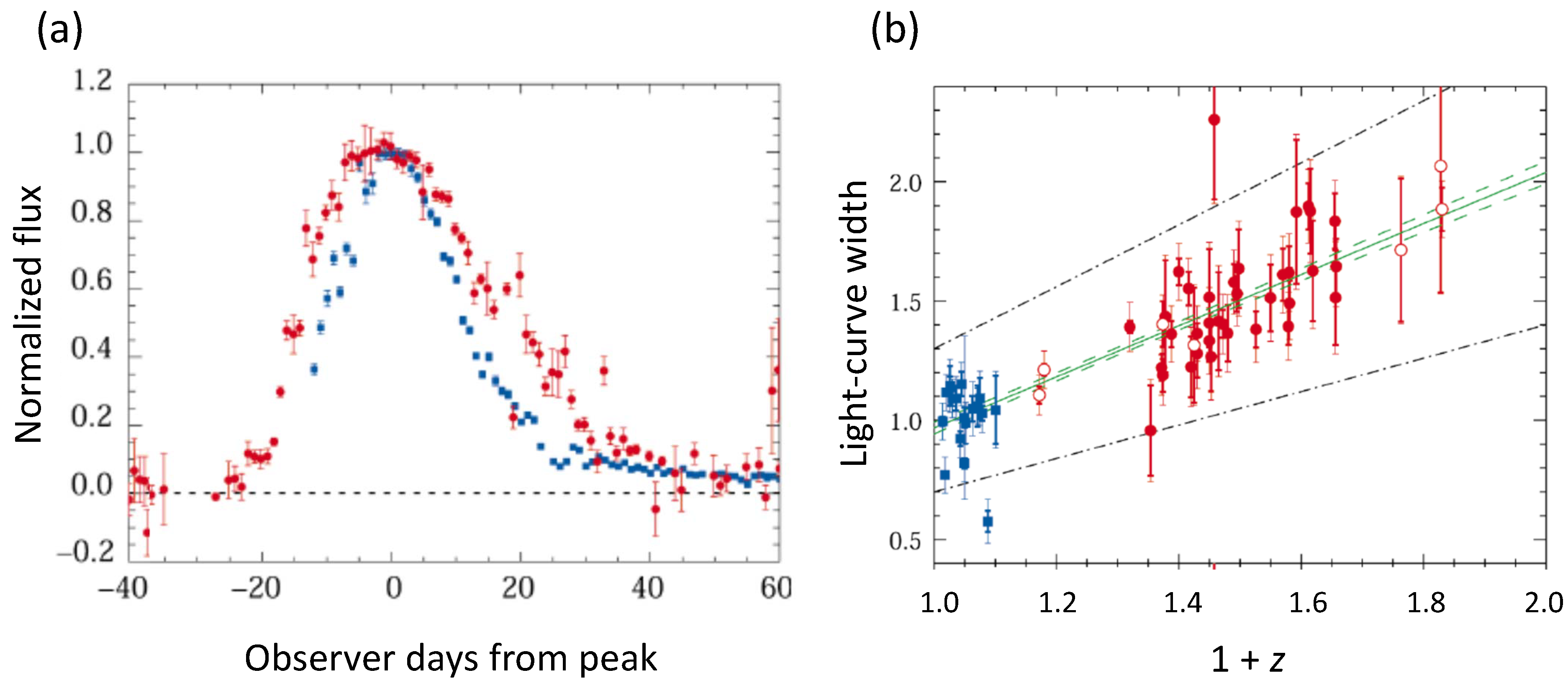
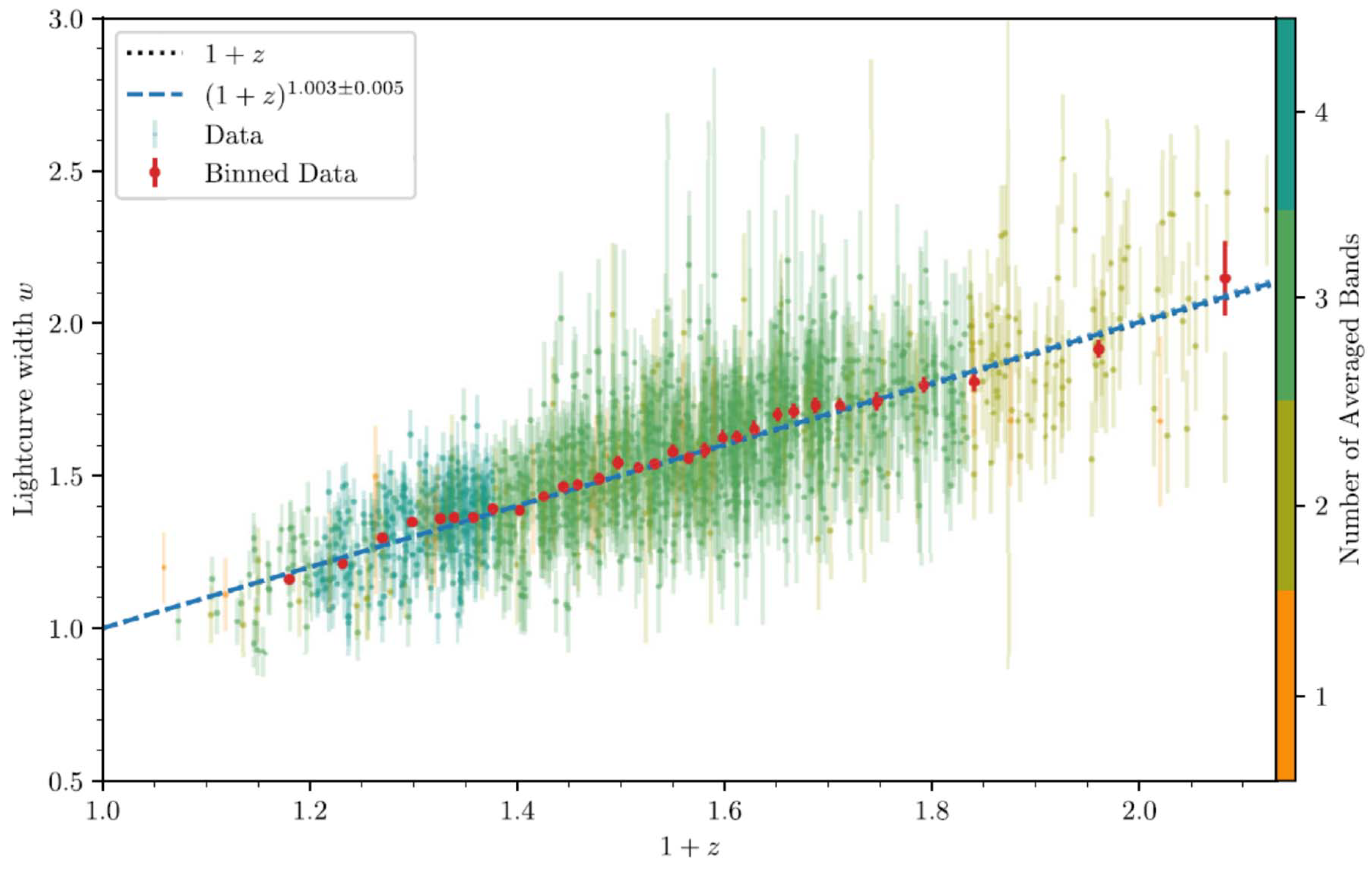
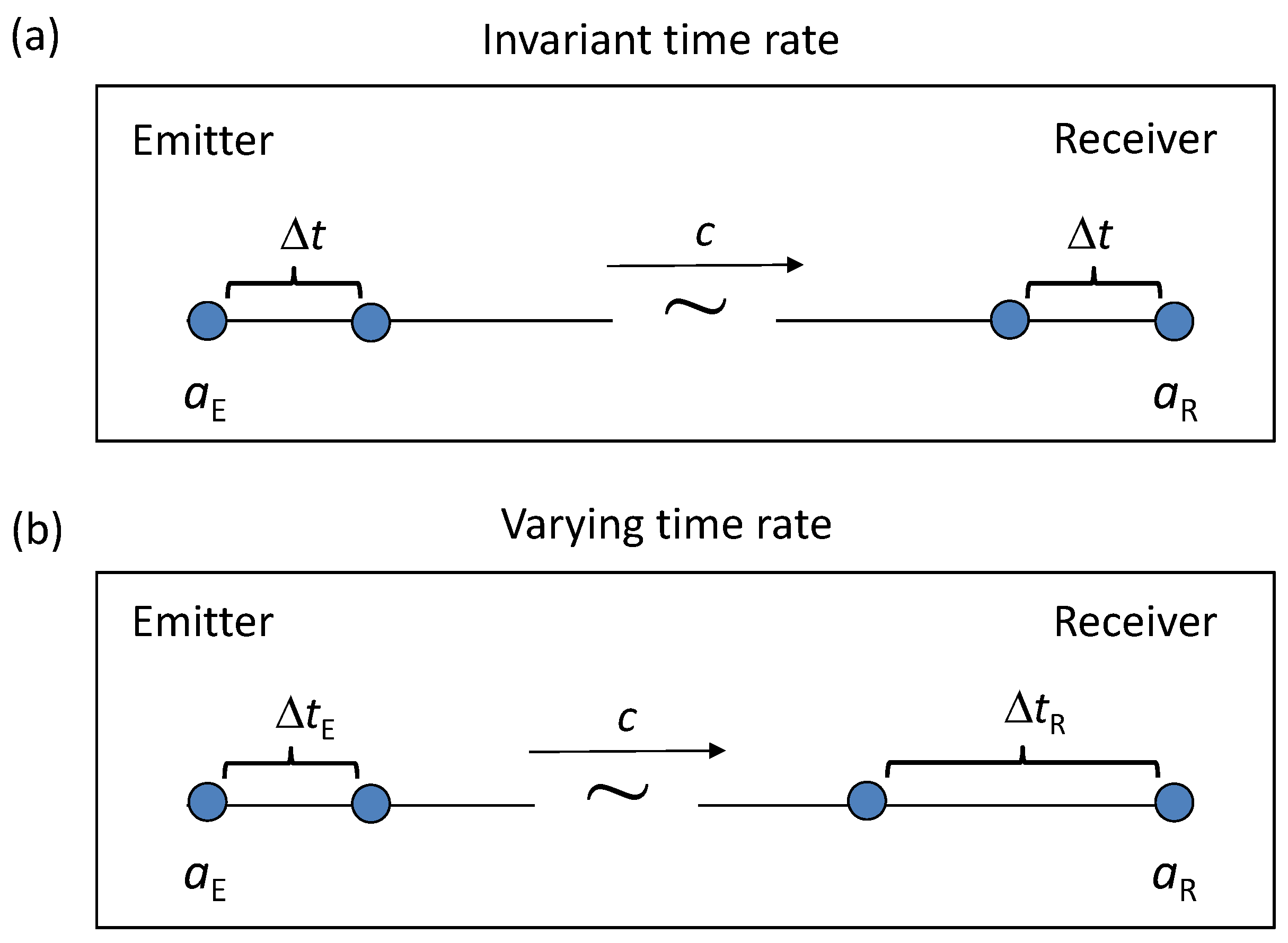
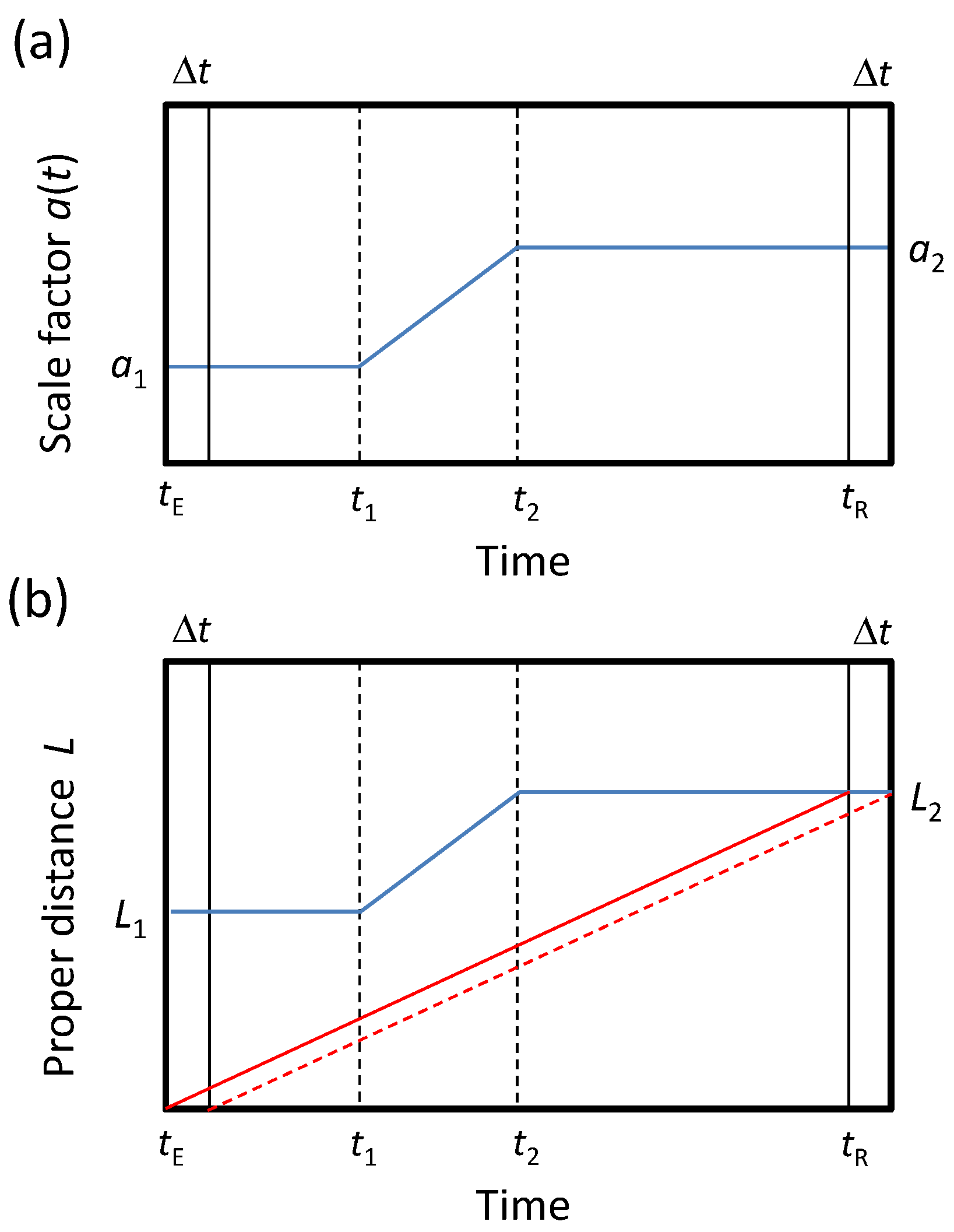
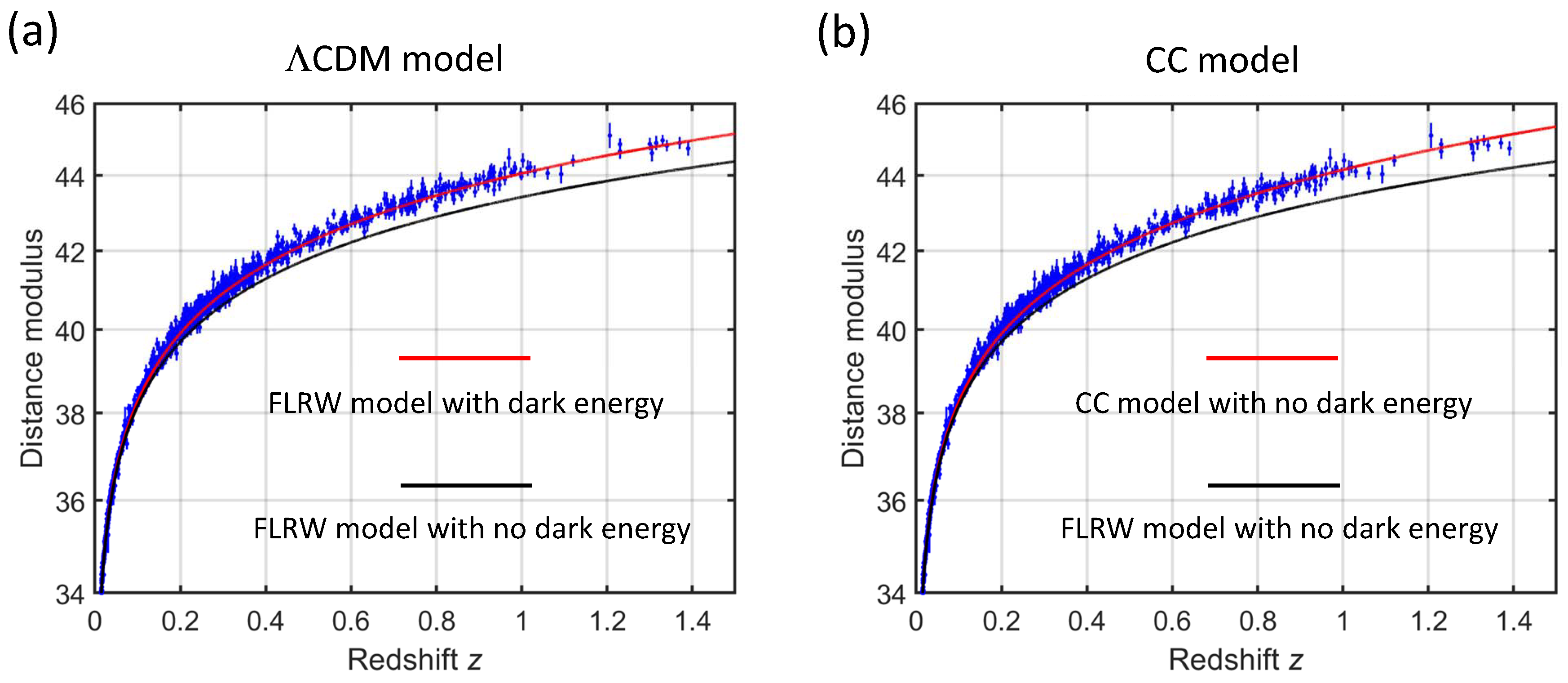
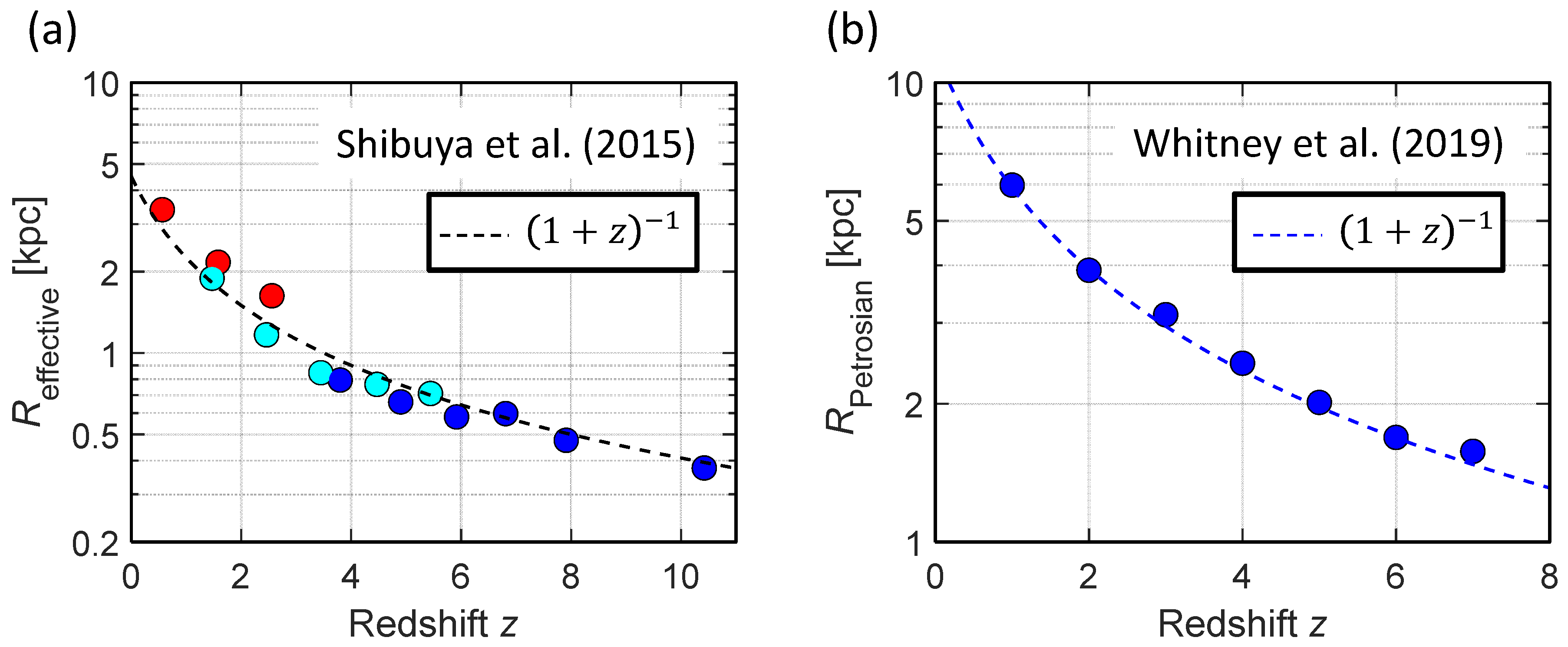
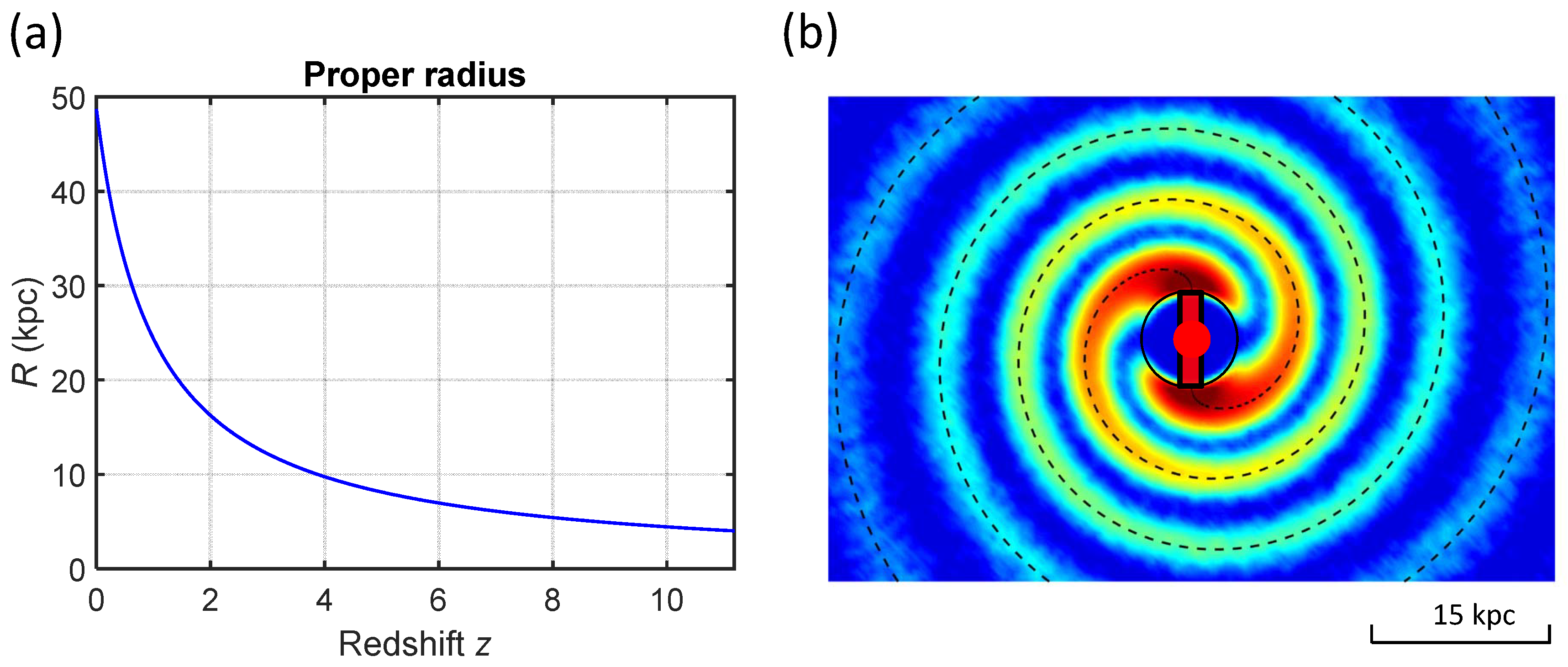
Disclaimer/Publisher’s Note: The statements, opinions and data contained in all publications are solely those of the individual author(s) and contributor(s) and not of MDPI and/or the editor(s). MDPI and/or the editor(s) disclaim responsibility for any injury to people or property resulting from any ideas, methods, instructions or products referred to in the content. |
© 2025 by the author. Licensee MDPI, Basel, Switzerland. This article is an open access article distributed under the terms and conditions of the Creative Commons Attribution (CC BY) license (https://creativecommons.org/licenses/by/4.0/).
Share and Cite
Vavryčuk, V. Time Dilation Observed in Type Ia Supernova Light Curves and Its Cosmological Consequences. Galaxies 2025, 13, 55. https://doi.org/10.3390/galaxies13030055
Vavryčuk V. Time Dilation Observed in Type Ia Supernova Light Curves and Its Cosmological Consequences. Galaxies. 2025; 13(3):55. https://doi.org/10.3390/galaxies13030055
Chicago/Turabian StyleVavryčuk, Václav. 2025. "Time Dilation Observed in Type Ia Supernova Light Curves and Its Cosmological Consequences" Galaxies 13, no. 3: 55. https://doi.org/10.3390/galaxies13030055
APA StyleVavryčuk, V. (2025). Time Dilation Observed in Type Ia Supernova Light Curves and Its Cosmological Consequences. Galaxies, 13(3), 55. https://doi.org/10.3390/galaxies13030055







